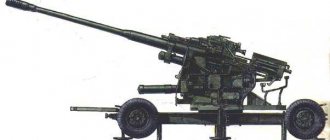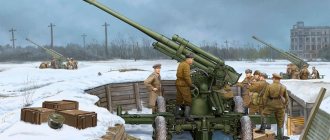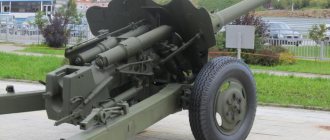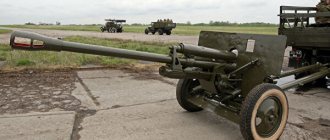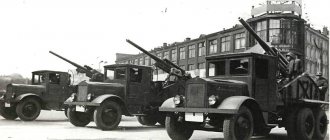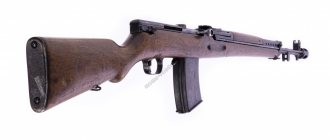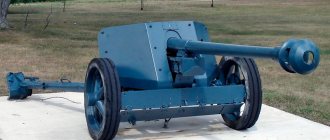The Soviet 37 mm anti-aircraft gun 61-K model 1939 is one of the main means of combating the country's air defense system during the Great Patriotic War. The gun is designed to combat low-flying single air targets of all types. In fact, the gun was often used by Soviet units as an effective anti-tank weapon in the most threatening tank-threat areas.
History of creation and mass production
The gun was created by decision of the Main Artillery Directorate by a team of designers under the leadership of M.N. Loginova. Soviet engineers based the design on the technical basis of the Swedish 40 mm anti-aircraft gun. The main design and assembly work was carried out at the plant named after. Kalinina. The first prototype was ready by October 1938, after which the gun was sent for military testing.
Crew of a 37 mm anti-aircraft gun on guard, North Caucasus, 1943
In 1939, the new Soviet anti-aircraft gun was put into service, receiving the official designation - 37-mm anti-aircraft automatic gun of the 1939 model and the GAU index - 52-P-167. The new automatic anti-aircraft gun was supposed to form the basis of the air defense of army units and subunits of the Red Army.
In the same year, mass production of the new Soviet anti-aircraft gun began. The main production base was the plant named after. Kalinina. Later, during the Great Patriotic War, serial production of the 37 mm anti-aircraft gun was transferred to plant No. 4 named after. Voroshilov, where it continued until 1945. A total of 22,600 guns in various modifications rolled off the factory assembly lines.
Control
Wasserfall(Germany)
Manual radio command control, visual. The targets were tracked visually by the operator, who then manually (using a joystick) brought the missile to the line of sight using commands from the station. The command control system used was a development of the standard German Kehl-Strasbourg, based on captured French designs from 1938–1940.
In the future, it was planned to use a pair of radars to track the target and the flying missile. The control, however, remained manual radio command: the operator saw the target and the missile as dots on the screen and tried to combine them using the joystick. The detonation of the warhead is command-based, based on visual assessment of proximity to the target.
Rating: Three points (you can give one point for the planned transition to radar tracking, but no more. Moreover, the system is stolen).
DAAC(Italy)
DAAC and Schmetterling: obvious similarities
Manual radio command control, visual. The goals are the same as in Wasserfall. The command control system is an original Campini design. The detonation of the warhead is command-driven, based on visual assessment of proximity to the target (the German version, however, received a proximity fuse)
Rating: Two points. The control system is primitive, dependent on visibility conditions and subject to human error.
Funryu-2(Japan)
1 — compressed air cylinder; 2 — control valves of the pneumatic system; 3 — vertical rudder servo drive; 4 — gyroscopic autopilot; 5 - radio receiver
Manual radio command control, visual. The target and the missile were tracked visually by the operator, who then manually (using buttons) with commands from the control station brought the missile to the target. The detonation of the warhead is command-based, based on visual assessment of proximity to the target.
Rating: Two points. Everything is the same as DAAC.
Brakemine(UK)
Automatic control, saddle beam method.” Rotating radar beamAANo. 3 Mk7 automatically tracked the selected target - the launched missile automatically kept itself within the beam path. The warhead was detonated using a proximity fuse.
Rating: Five points. The most advanced and effective control system of all missile defense systems tested during World War II. Fully automatic, independent of visibility conditions and resistant to interference.
KAN Little Joe(USA)
Manual radio command control, visual. The target and the missile were tracked visually by the operator. The work was done manually (using a joystick). The command system used is a standard AN/ARW-17 receiver and AN/ARW-19 transmitter combination designed for guided bombs.
Rating: Two points. The control system is exactly like DAAC and Funryu-2. But she had to solve the simplest problem: defeating a kamikaze heading straight for the ship.
Tactical and technical characteristics of the 37-mm anti-aircraft automatic gun of the 1939 model
- Calculation - 7 people.
- Combat weight - 2.1 tons.
- Loading is unitary.
- The initial speed of the fragmentation projectile is 880 m/s.
- Rate of fire - 160-180 rds/min.
- Damage zone: height 6.5 km, range - 8.5 km.
- Vertical guidance angle: from -5 to +85 degrees, horizontal guidance angle - 360 degrees.
- Main types of ammunition: anti-aircraft fragmentation, armor-piercing, sub-caliber shells.
- The weight of the fragmentation projectile is 1.4 kg.
- Transfer time from traveling to combat position: 25-30 seconds.
- Transportation method: transported by trucks.
The Soviet 37-mm anti-aircraft gun of the 1939 model went through the entire war with honor, ending its participation with salute salvoes in the defeated capital of the Third Reich. In the post-war years, the Soviet Union supplied this artillery system to the armies of friendly political regimes. The anti-aircraft gun took an active part in many armed conflicts of the second half of the 20th century.
Photo
Users[edit]
Current operators[edit]
- Angola [17]
- Algeria: ~150 [18]
- Bosnia and Herzegovina: 7 Type 55 [19]
- Bangladesh: 132 types 65/74 [20]
- Bolivia: 18 Type 65 [21]
- Burundi: type 55 [22]
- Cambodia [23]
- Cameroon: 18 Type 63 [24]
- People's Republic of China [25]
- Republic of the Congo: 28 [26]
- Democratic Republic of the Congo [27]
- Cuba [28]
- Egypt [29]
- Ethiopia [30]
- Gabon: 10 [31]
- Guinea: 8 [32]
- Guinea-Bissau: 6 [33]
- Iran [34]
- ISIS [ link needed
] - Israel [35]
- North Korea [36]
- Laos [37]
- Madagascar: 20 Type 55 [38]
- Mauritania: 10 [39]
- Mozambique: <100 [40]
- Myanmar: 24 Type 74 [41]
- Nepal [42]
- Pakistan: 310 Type 55/Type 65 [43]
- Seychelles [44]
- South Sudan: Type 65/Type 74 [45]
- Sudan: Type 63 and M1939 [46]
- Sri Lanka
- Syria [47]
- Tanzania: 120 [48]
- Thailand: 52 Type 74 [49]
- Togo: 5 [50]
- Tunisia: 15 Type 55/Type 65 [51]
- Uganda: 20 [52]
- Vietnam
- Zambia: 40 [53]
- Zimbabwe: 35 [54] [55] [56]
Former operators[edit]
| This section requires additional links for verification . |
- Afghanistan
- Albania
- Bulgaria [57]
- East Germany
- Finland
- Georgia
- Indonesia
- Iraq
- Morocco
- Mali
- Mongolia
- Malaysia
- Namibia
- Nicaragua
- Poland
- Romania
- Soviet Union
- Somalia
- Yemen
- Yugoslavia
- Zaire
Notes[edit]
- "104ème brigade de la Garde républicaine syrienne, troupe d'élite et étendard du régime de Damas". France-Soir
(in French). March 20, 2022. - ^ abc Chamberlain, Peter (1975). Anti-aircraft guns
. Gander, Terry. New York: Arco Pub. Co. p. 61. ISBN 0668038187. OCLC 2000222. - ^ abc Foss, Christopher (1977). Jane's Pocket Guide to Towed Artillery
. New York: Collier. paragraph 27. ISBN 0020806000. OCLC 911907988. - https://old.municion.org/37/37x252r.htm
- https://ww2data.blogspot.com/2015/07/soviet-explosive-ordnance-37mm-and-45mm.html?m=1
- ^ ab Shunkov V.N. - Weapons of the Red Army.
- DiGiulian, Tony. "Russia / USSR 37 mm / 67 (1.5″) 70-K - NavWeaps". Navweaps.com
. Retrieved June 07, 2022. - "Russian ammunition page". Archived from the original on 2009-10-23. Retrieved October 24, 2009.
- DiGiulian, Tony. "Russia / USSR 37 mm / 67 (1.5″) 70-K - NavWeaps". Navweaps.com
. Retrieved June 07, 2022. - DiGiulian, Tony. "Germany 3.7 cm/83 SK C/30 - NavWeaps". navweaps.com
. Retrieved June 7, 2022. - DiGiulian, Tony. "France 37mm/50 (1.46") Model 1925 and Coal Model 1933 - NavWeaps". Navweaps.com
. Retrieved 2017-06-07. - DiGiulian, Tony. "Italy 37mm/54 (1.5") Models 1932 1938 and 1939 - NavWeaps". Navweaps.com
Verified. 2017-06-07. - "37mm M1A2 L/53.5". Tarrif.net
. Archived from the original on 2011-01-27. - DiGiulian, Tony. "Germany 3.7 cm / 57 (1.5") Anti-aircraft M43 - NavWeaps". Navweaps.com
Verified. 2017-06-07. - DiGiulian, Tony. "United Kingdom/UK 2-pounder QF Mark VIII - NavWeaps". navweaps.com
. Retrieved June 7, 2022. - DiGiulian, Tony. "USA Bofors 40 mm/60 Model 1936 - NavWeaps". navweaps.com
. Retrieved June 7, 2022. - Military Balance 2016, p. 429.
- Military Balance 2016, p. 320.
- Military Balance 2016, p. 81.
- Military Balance 2016, p. 236.
- Military Balance 2016, p. 381.
- Military Balance 2016, p. 433.
- Military Balance 2016, p. 239.
- Military Balance 2016, p. 434.
- Military Balance 2016, p. 242.
- Military Balance 2016, p. 438.
- Military Balance 2016, p. 441.
- Military Balance 2016, p. 393.
- Military Balance 2016, p. 325.
- Military Balance 2016, p. 445.
- Military Balance 2016, p. 446.
- Military Balance 2016, p. 449.
- Military Balance 2016, p. 450.
- Military Balance 2016, p. 328.
- Military Balance 2016, p. 335.
- Military Balance 2016, p. 265.
- Military Balance 2016, p. 271.
- Military Balance 2016, p. 454.
- Military Balance 2016, p. 344.
- Military Balance 2016, p. 458.
- Military Balance 2016, p. 276.
- Military Balance 2016, p. 277.
- Military Balance 2016, p. 280.
- Military Balance 2016, p. 465.
- Military Balance 2016, p. 469.
- Military Balance 2016, p. 471.
- Military Balance 2016, p. 354.
- Military Balance 2016, p. 473.
- Military Balance 2016, p. 294.
- Military Balance 2016, p. 474.
- Military Balance 2016, p. 356.
- Military Balance 2016, p. 475.
- Military Balance 2016, p. 476.
- Military Balance 2016, p. 478.
- Hussein, Solomon (1988). Towards a common defense and security policy in the Southern African Development Community
. Pretoria: African Institute of South Africa. pp. 109–111. ISBN 978-0798301749. - "Zimbabwe Defense Force". defenseweb.co.za. October 13, 2014. Archived from the original on November 15, 2022. Retrieved June 28, 2015.
- 257 units were exported to Bulgaria in 1945-1948 - History of the Anti-Aircraft Artillery and Anti-Aircraft Missile Troops in the Bulgarian Army, Sofia 1995, p. 102-103. (History of anti-aircraft artillery and anti-aircraft and missile forces of the Bulgarian army, Sofia, 1995, pp. 102-103.)
Cumulative ammunition
The Germans encountered the problem of insufficient armor penetration of the RAK 35/36 gun during the war with France, when these guns had difficulty hitting heavy French tanks with more powerful armor. The 37-mm anti-tank gun ceased to completely meet the needs of the army in 1941, when it met the latest Soviet T-34 and KB-1 tanks. During this period, the Wehrmacht found itself practically without anti-tank weapons. At the same time, quite a lot of 37-mm guns were produced, so the German industry in 1941 urgently developed a new ammunition - an over-caliber cumulative action mine model 41 (index 3.7 cm Stiel-Gr.41), which used a mixture as an explosive phlegmatic RDX with TNT, pressed into a paper case and equipped with an instantaneous head fuse and an inertial bottom fuse (AZ 5075 and Bd.Z.5130, respectively). The color of the mine is dark green protective. Ammunition arr. 41 3.7 cm Stiel-Or.41 is a mine with an ejector propulsion system, consisting of an over-caliber cumulative warhead, a thin-walled tube body, a rod placed in the tube body, and a stabilizer. To launch a mine at a target, a standard cartridge case with a primer and a powder charge from a 37-mm PAK 35/36 cannon is used.
When firing, the mine is placed with its rod from the muzzle into the gun barrel, and the cartridge into the chamber. Then the primer is pierced, the powder charge in the cartridge is ignited, and the gases eject the mine in the direction of the target. It is stabilized in flight by a stabilizer in the tail section. When a tank is hit, the fuses are triggered, the cumulative warhead is detonated, and the formed cumulative jet “burns through” the armor.
Storage and transportation of ammunition is carried out in a special metal case with a diameter of 225 mm and a height of 765 mm. The weight of the case with ammunition and expelling charge in a standard cartridge case is 16.85 kg, the weight of the case without ammunition is 7.65 kg. There is a marking on the cover of the case and on the combat surface - Min.3.7 cm Pak (Stiel-Gr.).
Main characteristics of over-caliber ammunition mod. 41 3.7 cm Stiek.-Gr. 41 are as follows: weight 9.15 kg; length - 712.0 mm; mass of propellant charge - 0.210 kg (gunpowder Ngl.Man.NP-12.5-(4.4.1); mass of igniter made of pyroxylin porous powder brand Nz.Man.NP (1.5.1.5) - 4 g; mass of cumulative combat parts - 2.28 kg.
Further modernization of the 37-mm anti-tank gun and the development of a new cumulative ammunition (3.7 cm Stiel-Gr.42(t)) could not significantly increase the effectiveness of the artillery system as a whole and the armor penetration of its ammunition. In this regard, the Pak 35/36 anti-tank gun was transferred to garrison service units and military schools, where it was used until the end of World War II.
